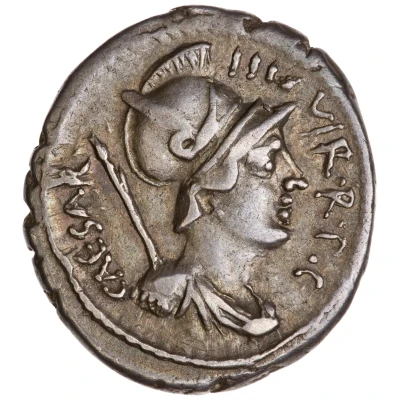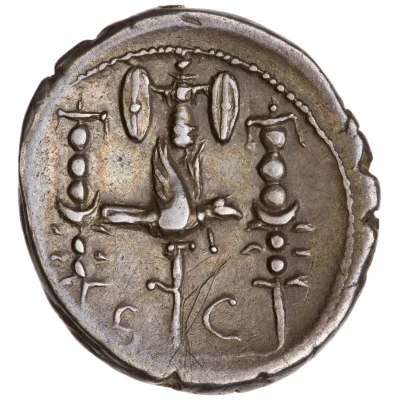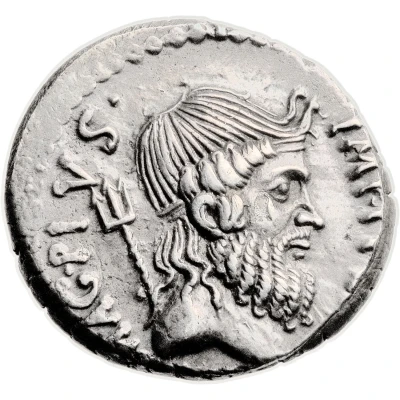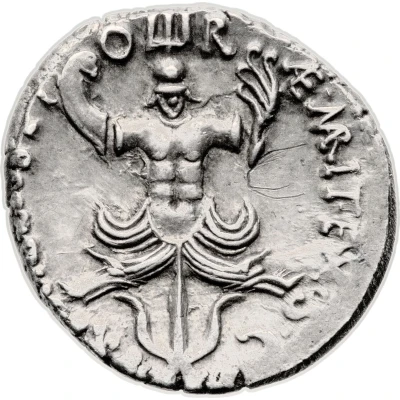


Denarius Q. Cornuficius; Q•CORNVFICI•AVGVR•IMP 42 BC
42 BC year| Silver | 3.46 g | 19 mm |
| Issuer | Rome › Roman Republic (509 BC - 27 BC) |
|---|---|
| Period | Republic (509 BC - 27 BC) |
| Type | Standard circulation coin |
| Year | 42 BC |
| Value | Denarius (1) |
| Currency | Denarius of 16 Asses (141 – 27 BC) |
| Composition | Silver |
| Weight | 3.46 g |
| Diameter | 19 mm |
| Shape | Round (irregular) |
| Technique | Hammered |
| Orientation | Variable alignment ↺ |
| Demonetized | Yes |
| Updated | 2024-10-06 |
| Numista | N#390602 |
|---|---|
| Rarity index | 100% |
Reverse
Q. Cornuficius standing left, wearing veil and holding lituus in right hand; on right, Juno Sospita, with crow perching on shoulder, holding spear and shield in left hand and with right hand crowning Q. Cornuficius. Border of dots.
Script: Latin
Lettering: Q•CORNVFICI•AVGVR•IMP
Comment
Babelon Cornuficia 2; RBW –.
Of the highest rarity and one of the most difficult issues of the Roman Republic series.
By the time he was appointed governor of Africa Vetus (the 'old' province) in 44 B.C., Quintus Cornuficius had already enjoyed a distinguished career in government and as a poet and orator. He counted among his friends Catullus and Cicero, and had been a loyal ally of Julius Caesar in his struggle against the Pompeians. After the murder of Caesar, Cornuficius voiced his opposition to the Triumvirs: he sided with the senate in the War of Mutina (43 B.C.), refused to allow Antony's nominee to replace him as governor, and thus was named in the Triumviral proscriptions. From his base in Africa, he aided Sextus Pompey and allowed many of those who also had been proscribed to take refuge in his territory. Cornuficius' vocal opposition to the Triumvirs, however, proved to be his undoing, for in 42 B.C. he was attacked by Titus Sextius, governor of neighbouring Africa Nova (the 'new' province). The fact that Cornuficius was hailed Imperator and was able to produce an intriguing coinage with his title suggests his defence was initially successful before, late in the year, he was defeated and killed near Utica.
His coin designs are highly personal, and the few dies used to produce them were engraved in unusually fine style. He chose for the obverse of his coins the portraits of Ceres-Tanit, Africa and Jupiter Ammon, all of which celebrated his province. These were paired with a single reverse type that showed Cornuficius being crowned by Juno Sospita. The fact that he is veiled, holds a lituus and includes AVGVR in the inscription underscores the pride he held in the augurate to which he had been appointed by Julius Caesar in 47 B.C. Since he is crowned by Juno Sospita, we should assume that it is a reference to his Lanuvine origin.
@Numismatica Ars Classica
Interesting fact
The Denarius coin was used as a means of payment for Roman soldiers, and it was also used to pay taxes. In fact, the Roman Empire's tax system was based on the value of the Denarius, with certain taxes being equivalent to a certain number of Denarii. This coin was an integral part of the Roman economy and played a significant role in the empire's financial transactions.



